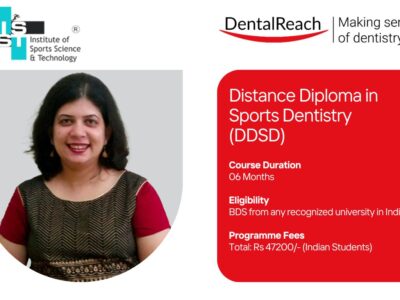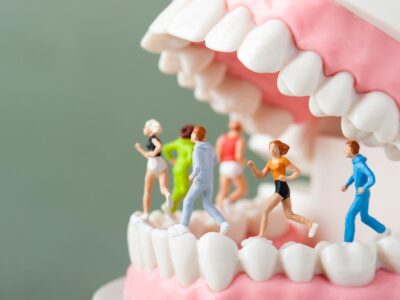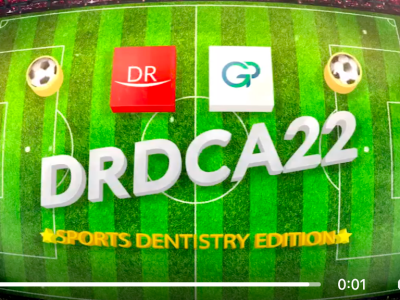Keywords: sports dentistry, mouthguard, athlete oral care
Introduction
A physically active lifestyle is important for all age groups. Reason to participate in sports and physical activity are many such as pleasure, relaxation, competition, socialization, maintenance and improvement of fitness and health. Participation in sports offers potential benefits for individuals of all ages, such as combating obesity and enhancing cardiovascular fitness.
Today in India, thousands of school children play at least one organized sport. However, it is of growing concern about the injuries that occur during participation in organized sports. Injuries during sport appear to be unavoidable, and up to 30% to 40% of all accidents in children and adolescents occur during sports. The prevalence of sports injuries vary widely. Injuries in youth sports account for substantial morbidity and cost. In many cases, these types of injuries are due to overuse of a part of the body when participating in a certain activity. Recommendations made for preventing sports injuries are
- promotion of using protective equipment and
- adequate warming up before competition or routine prophylaxis program before the start of training sessions or playing competitive games.
Since increasingly many youth are involved in sport programs, health and safety are major issues. That is why, use of protective equipment is become a necessity.
Increase in Dental Injuries in Sports and Need of Mouthguards
Dental injuries are the most common type of oro-facial injury sustained during participation in sports with the increased popularity of contact sports. Contact sports are defined as those sports in which players physically interact with each other, trying to prevent the opposing team or person from winning. Dental and soft tissue injuries are commonly associated with collision and contact sports such as football, ice hockey, soccer, baseball, bicycling, inline skating, gymnastics, basketball, alpine skiing, softball, volleyball, karate, mountain biking and skateboarding.
Incidence of sports related oral injury vary widely based on the sport played, level of competition, the participant’s age and sex. Dental trauma in sports differ from other dental trauma, as it is possible to easily prevent it and there is also a possibility to dramatically reduce the occurrence levels by the use of mouthguards that protect all dental and periodontal structures.
The best way to convince an athlete for using a mouthguard is to explain the economic viability. The recovery process after dental and facial trauma is often lengthy and multiple surgeries with a multidisciplinary post-operative rehabilitation process may be needed. Along with the public image of the athlete, eating and talking and social interaction can get affected which may add to the frustration of the athlete. Even in case only dental trauma to few teeth, rehabilitation costs are high.
So What are Mouthguards?
Definition: The American Society for Testing and Materials (ASTM) designation F 697-80 entitled the following definition for a mouthguard (or mouth protector):
“A resilient device or appliance placed inside the mouth (inside or outside), to reduce mouth injuries, particularly to the teeth and surrounding structures.”
Properties: The properties of a properly fitted mouthguard as defined by Academy of Sports Dentistry (ASD) are as follows:
- Adequate thickness in all areas to provide the reduction of impact forces.
- A fit that is retentive and does not dislodge on impact.
- Speech consideration equal to demands of the playing status of athlete.
- A material that meets U.S. food and drug administration approval.
Preferably a wearing duration of time equal to one season of play.
Benefits of Using Mouthguards
- Help to reduce the possibility of being concussed and suffering brain damage.
- Provide with more comfort and make it easier to breathe and speak.
- Enable to compete more competitively and perform more confidently.
- Reduce the possibility of teeth being fractured or lost.
- Reduce the possibility of jaw being dislocated or fractured.
- Reduce the risk of cuts and bruising the mouth and disfiguring the face.
Classification of Mouthguards
According to the ASTM, the classification of athletic mouthguards is as follows
Type I Stock Mouthguards
They are purchased over the counter by athletes from sporting goods stores and are the least expensive of the three types of mouthguards available. They come in a variety of styles and colors, with or without straps. They are ready to wear because one size is intended for all users. These mouthguards are not adapted to the dentition of the athlete, so that they must be held in place by biting the teeth together. Because they are the least retentive and often bulky, stock mouthguards interfere most with the athletes ability to breathe and speak and often cause the athlete to gag. Because of all these factors, stock mouthguards are unacceptable to most athletes and offer the least protection for the prevention of sports related dento-facial injuries.

Type II Mouth formed mouth guards
They are intermediate between the stock and custom fabricated types. They come in 2 varieties: shell lined and boil & bite.
Shell-lined variety: It is fabricated by placing freshly mixed ethyl methacrylate into a hard shell, which is then inserted into the athlete’s mouth until the material sets. Although offering relatively good adaptation to the dental arch, this variety is often too bulky and uncomfortable as well as having an unpleasant odour and taste. For better results, the liner should be changed after each use. Consequently, the shell-lined variety has lost favour with athletes and is often not used.
Boil-and-bite variety: It is the most widely used type of mouthguard. These mouthguards are fabricated by placing the mouthguard form into boiling water to soften the material. The softened material is then placed into the athlete’s mouth and adapted.

In countries like U.S. and UK, a lot of progress has been made in engineering the boil-and bite EVA mouthguard for better fit, comfort and protection. This includes sophisticated multilayer composites with a different softening temperature, custom gel fit liner, grip fit technology, OPROfin™ retention system, or blending EVA with various polymers such as Kraton and polyurethane.

Despite so many efforts, a properly fitted boil-and-bite mouthguard is still difficult to achieve and many athletic trainers and sports participants still prefer the custom-fabricated mouthguards (Type III), i.e. from dentist-made stone casts of the athlete’s dental arches. They have superior features as we will see below.
Type III Custom-fabricated Mouthguards
They are made professionally over a dental cast of the athlete’s arch. They are considered superior than either stock or mouth-formed mouthguards. Because of their superior adaptation and retention, custom-fabricated mouthguards are believed to interfere least with breathing and speech. Because of superior fit and comfort, they are more likely to be accepted by the athletes. These type of mouthguards are considered to be more protective because they confirm more closely to the athlete’s mouth, and the material thickness covering the critical chewing platform (or bite table) can be better controlled during laboratory fabrication.

Guide for using Mouthguard in Various Sports
The American Dental Association (ADA) and the Academy of Sports Dentistry (ASD) recommend properly fitted mouthguards for variety of recreational activities and sports that place participants at risk for orofacial injuries.

Global Mouthguard Market Report: Opportunities Analysis and Industry Forecast 2021 to 2030 (by Allied Market Research)
Eminence of national & international sports events, growth in consumer awareness regarding health & fitness, and rise in participation in sports activities have led to increased demand for mouthguard, thereby supplementing the mouthguard market demand.
The global mouthguard market was valued at $189.4 million in 2020, and is projected to reach $369.9 million by 2030, registering a CAGR of 6.6% from 2021 to 2030. In 2020, the boil and bite mouthguard segment accounted for the highest share in the mouthguard market size. It is expected to remain dominant during the mouthguard market forecast period. It is a cost-effective product and provides a good individual fit than stock mouthguard. Although it may give a better fit than stock mouthguard, it might be bulky and does not provide the same fit and protection as a custom-fitted mouthguard.
What is encouraging for the dentist is that the custom-fabricated mouthguard segment would witness the fastest growth, registering a CAGR of 7.3% during the forecast period (2021 to 2030).
Conclusion
It is important that all dentists interested in sports dentistry should focus on giving custom fabricated mouthguards and/or high quality bite-&-boil mouthguards as second best alternative to athletes. Mouth protection must be made mandatory for selected sports in the country. The dental and the sporting community should come together for this and help in development of mouthguard policies. The dentists should make athletes, parents, coaches and sports healthcare professionals aware about of mouthguard use in various sports. Only then will the widespread use of mouthguards will happen. Save the teeth, save a life!




















Comments